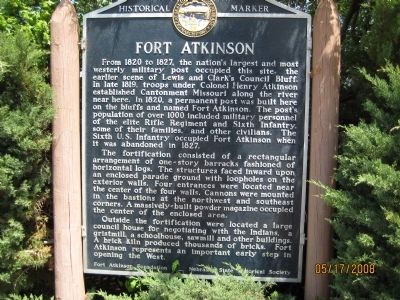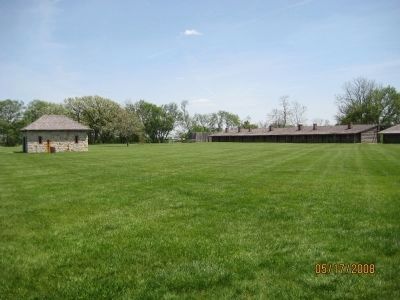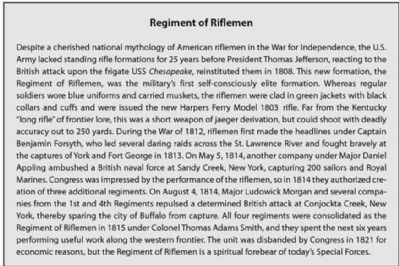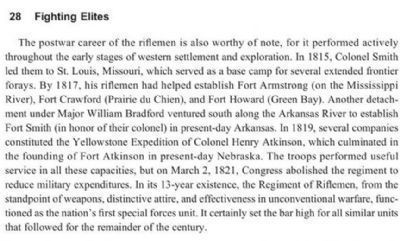Fort Calhoun in Washington County, Nebraska — The American Midwest (Upper Plains)
Fort Atkinson
From 1820 to 1827, the nation's largest and most westerly military post occupied this site, the earlier scene of Lewis and Clark's Council Bluff. In late 1819, troops under Colonel Henry Atkinson established Cantonment Missouri along the river near here. In 1820, a permanent post was built here on the bluffs named Fort Atkinson. The post's population of over 1000 included military personnel of the elite Rifle Regiment and Sixth Infantry, some of their families, and other civilians. The Sixth U.S. Infantry occupied Fort Atkinson when it was abandoned in 1827.
The fortification consisted of a rectangular arrangement of one-story barracks fashioned of horizontal logs. The structures faced inward upon an enclosed parade ground with loopholes on the exterior walls. Four entrances were located near the center of the four walls. Cannons were mounted in the bastions at the northwest and southeast corners. A massively-built powder magazine occupied the center of the enclosed area.
Outside the fortification were located a large council house for negotiating with the Indians, a gristmill, a schoolhouse, sawmill and other buildings. A brick kiln produced thousands of bricks. Fort Atkinson represents an important early step in opening the West.
Erected by Fort Atkinson Foundation, Historical Land Mark Council, and the Nebraska State Historical Society. (Marker Number 67.)
Topics and series. This historical marker is listed in these topic lists: Exploration • Forts and Castles • Native Americans • Settlements & Settlers. In addition, it is included in the Nebraska State Historical Society series list.
Location. 41° 27.126′ N, 96° 0.816′ W. Marker is in Fort Calhoun, Nebraska, in Washington County. Marker can be reached from Madison St, 0.8 miles east of U.S. 75. Located Inside Fort Atkinson State Historical Park. Touch for map. Marker is in this post office area: Fort Calhoun NE 68023, United States of America. Touch for directions.
Other nearby markers. At least 8 other markers are within 6 miles of this marker, measured as the crow flies. Lewis and Clark Campsite (approx. ¼ mile away); The Death of Marshal Suverkrubbe (approx. 0.7 miles away); a different marker also named Fort Atkinson (approx. 0.7 miles away); The Lewis and Clark Expedition (approx. 4.4 miles away); Up the Missouri (approx. 4.4 miles away); Steamboat Bertrand (approx. 4.9 miles away); Lewis and Clark Campsite Area (approx. 5 miles away); DeSoto Townsite (approx. 5.4 miles away). Touch for a list and map of all markers in Fort Calhoun.
Also see . . . Welcome to Fort Atkinson Historical State Park.
The Friends of Fort Atkinson Website (Submitted on May 18, 2008, by Michael James of Fort Calhoun, Nebraska.)
Additional commentary.
1. The Rifle Regiment - A Forgotten Unit from a Forgotten War and its role in Western Expansion
Fort Atkinson was the last "home" for the "elite" Rifle Regiment - this largely unremembered "Regular Army" unit deserves a better fate!
The pre-eminent historian of the U.S. Army in the War of 1812, John C. Fredriksen, paid this tribute in Green Coats and Glory: The United States Regiment of Riflemen, 1808-1821: "The Regiment of Riflemen was unquestionably the most effective infantry formation fielded by the United States in the War of 1812...Accurate weapons, a soaring esprit de corps and inspired leadership.... all resulted in consistently superior performance."
Attached (see pictures on this page) are two short summaries by Fredriksen, which capture the exploits and achievements of this unique unit.
3. from The United States Army: A Chronology, 1775 to the Present, by John C. Fredriksen, 2010, "Regiment of Riflemen," p. 63
4. from Fighting Elites: A History of U.S. Special Forces, by John C. Fredriksen, 2011, p. 28
"Although virtually forgotten today, the post itself was a strong one. Initially it had the strongest garrison of any fortification within the bounds of the United States or her territories at that time. [1,120 men]. As representative of the armed strength of the United States, the outpost paved the way for the fur trading expeditions who were penetrating the Plains-Rocky Mountain region. The efforts of the men of the Sixth Infantry and the Rifle Regiments to build Cantonment Missouri in October 1819, are colorfully revealed in the orderly books of these two regiments. " Johnson, p. 121
CANTONMENT MISSOURI, 1819-1820, by SALLY A. JOHNSON, Nebraska History, Volume 37, Number 2, June, 1956
http://www.usgennet.org/usa/ne/topic/resources/NSHS/CMO/cantonmo.html
The Rifle Regiment "led the way" on the expedition up the Missouri...and in building the cantonment: "Once the barracks were erected, Camp Missouri officially assumed the name Cantonment Missouri....Captain Bliss made the following report..."The police in front of the Rifle Corps is generally very good, that of the [6th] Infantry is bad..."...the Rifle Regiment [strength was] approximately 608 noncommissioned officers and privates....the Sixth Regiment (the smaller of the two regiments)...460 noncommissioned officers and privates." Johnson, pp. 124-126
The winter months of 1819-1820 saw the combined effects of a lack of supplies, harsh winter weather, poor sanitation, drainage difficulties, and disease mainly widespread scurvy, decimate the ranks and claim the lives of over 150 of the 1,120 men. The scurvy, owing to the absence of fresh vegetables (poor nutrition and lack of vitamin C), was recognized and eventually brought under control by the efforts of the regimental surgeons. By spring, the post included an adjacent one hundred acres of promising cultivated farmland. (Colonel Virgil Ney extolled the example set by the troops in farming - as one to the entire nation - in the potential of what was erroneously believed to be a vast wasteland -ironically conveyed by the report of Major Stephen H. Long who led another part of the Yellowstone Expedition, a pioneering scientific survey, the first of the region.)
FORT ON THE PRAIRIE: FORT ATKINSON ON THE COUNCIL BLUFF, 1819-1827, by Colonel Virgil Ney, 1979 and
http://en.wikipedia.org/wiki/Fort_Atkinson_%28Nebraska%29
Note To Editor only visible by Contributor and editor
— Submitted April 23, 2012, by Russ Grimm of Hampton, Virginia.
Credits. This page was last revised on May 15, 2023. It was originally submitted on May 17, 2008, by Michael James of Fort Calhoun, Nebraska. This page has been viewed 2,102 times since then and 40 times this year. Last updated on May 14, 2023, by Jeff Leichsenring of Garland, Texas. Photos: 1, 2. submitted on May 17, 2008, by Michael James of Fort Calhoun, Nebraska. 3, 4. submitted on April 23, 2012, by Russ Grimm of Hampton, Virginia. • J. Makali Bruton was the editor who published this page.



